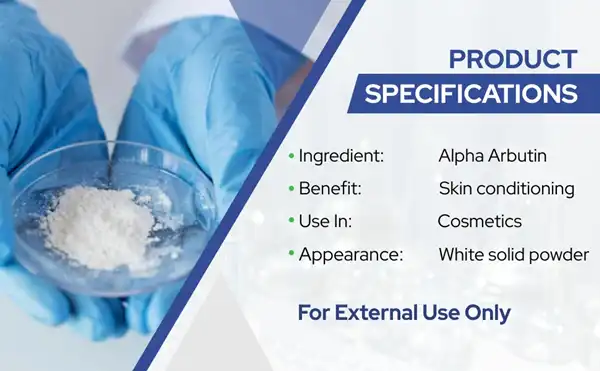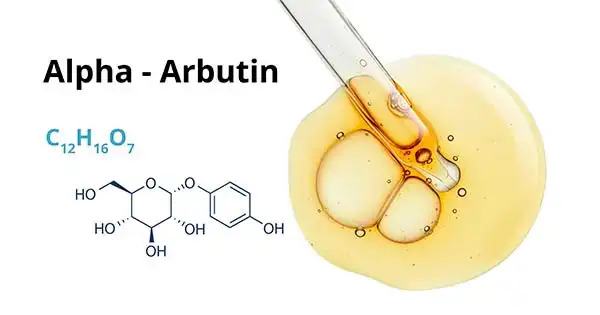Is Alpha Arbutin an AHA?
Alpha Arbutin Powder is gaining popularity as a gentle skin brightener. But is it an acid like AHAs (alpha hydroxy acids)? Does it peel like glycolic acid or lactic acid? Or then again does it work another way to repress pigmentation? Here is a profound plunge into what alpha arbutin is, the way it deals with the skin, and in the event that it qualifies as an AHA.
What Is Alpha Arbutin?
Alpha Arbutin Powder is derived from the leaves of the bearberry plant. It's considered a naturally-derived skin lightening alternative to standard hydroquinone.
The molecular structure of Alpha Arbutin Powder consists of arbutin attached to a hydroquinone molecule. But it works differently than straight hydroquinone. After absorbing into the skin, the alpha arbutin breaks down into its two components. The arbutin remains at the skin's surface while the hydroquinone penetrates deeper.
This dual action helps alpha arbutin gently:
- Inhibit tyrosinase: This enzyme controls melanin production. Alpha arbutin helps block new melanin synthesis.
- Exfoliate pigmented cells: The top layer of arbutin gently sheds pigmented skin cells.
By reducing melanin and increasing cell turnover, alpha arbutin gradually improves areas of discoloration and hyperpigmentation. It's gentler than many mainstream lighteners.

Is Alpha Arbutin an Acid?
Pure Alpha Arbutin Powder is not classified as an acid. In spite of the presence of "alpha" in its name, alpha arbutin doesn't have a place with the class of acids like alpha hydroxy acids (AHAs). AHAs, for example, glycolic corrosive and lactic corrosive, are carboxylic acids that shed the skin by separating the connections between skin cells, advancing cell turnover, and further developing skin surface.
In contrast, Pure Alpha Arbutin Powder functions as a skin brightening agent and is considered a precursor to hydroquinone. When applied topically, alpha arbutin is changed over into hydroquinone, which works by hindering the catalyst tyrosinase liable for melanin creation. By reducing melanin synthesis, alpha arbutin helps to lighten dark spots, even out skin tone, and improve hyperpigmentation.
Alpha arbutin's component of activity varies from that of acids like AHAs, as it doesn't straightforwardly exfoliate the skin. All things considered, it targets melanin creation to resolve issues connected with skin staining and pigmentation.
Gotten from regular sources, for example, bearberry plants, alpha arbutin is leaned toward for its skin-lighting up properties and its capacity to advance an all the more even coloring without the unforgiving impacts of exfoliating acids.. It is in many cases picked as a delicate option in contrast to conventional easing up fixings like hydroquinone or kojic acid because of its viability and skin-accommodating nature.
In conclusion, while alpha arbutin may share a similar name structure with acids, it is not an acid itself. All things considered, it fills in as an important part in skincare plans pointed toward tending to hyperpigmentation and advancing a more brilliant, more uniform complexion through its novel melanin-repressing properties.
How Does Alpha Arbutin Compare to Other Skin Lighteners?
Here's how alpha arbutin stacks up to other common lightening ingredients:
Hydroquinone: Strongly inhibits melanin but with a risk of irritation and oxidative damage. Alpha arbutin converts to hydroquinone but causes less side effects.
Kojic acid: Derived from fungi, potentially irritating. Alpha arbutin is gentler.
Vitamin C: Antioxidant that may brighten by blocking tyrosinase. Fades pigmentation gradually and safely. Alpha arbutin is similar but more targeted.
Azelaic acid: Exfoliates pigmented skin cells but less irritating than AHAs. Alpha arbutin also gently sheds pigmented skin without irritation.
Niacinamide: Blocks melanin transfer to skin cells, reducing discoloration with little risk of side effects. Alpha arbutin is another safe melanin inhibitor.
While reactions vary for individuals, alpha arbutin tends to be gentler than many mainstream lighteners. It can be used by those too sensitive for other brightening ingredients. But those with very stubborn pigment may need something stronger.

Is Alpha Arbutin Safe?
When used properly, alpha arbutin is considered very safe for most skin types. Potential pros of alpha arbutin include:
-Gotten normally from bearberry plants
- Converts to hydroquinone yet with lower hazard of aftereffects
- Causes less disturbance than other lighteners like hydroquinone or kojic corrosive
- Great choice for touchy skin that can't endure other brighteners
Be that as it may, there are a few precautionary measures to know about:
- Might possibly cause disturbance, tingling, or redness assuming that skin is delicate
- Sun responsiveness might increment, requiring industrious sunscreen use
- Long haul security information is restricted contrasted with different ingredients
- Undependable for pregnancy or breastfeeding (hydroquinone risk)
While alpha arbutin is likely safer than hydroquinone and many other lighteners, take care if you have very sensitive skin. Start slow and monitor for any reactions. And limit use if pregnant or nursing since converted hydroquinone can be absorbed. But with proper precautions, alpha arbutin can be a gentle brightening option.
How Should You Use Alpha Arbutin?
Alpha arbutin is sold in creams, serums, masks, peels, and spot treatments ranging from 2-7% concentration. Use products with 3-4% alpha arbutin 1-2 times daily for the best brightening boost. Apply a broad spectrum sunscreen daily as increased sun sensitivity is possible.
For optimal results, use alpha arbutin consistently for 8-12 weeks. Results appear gradually over time. It inhibits melanin and promotes cell turnover, but does not wipe pigment away overnight like a peel. Be patient!
Search for extra lighting up ingredients like niacinamide or vitamin C to improve the impacts. Exfoliating AHAs can boost cell turnover but may cause irritation.
Stop use if any stinging, itching, or redness occurs. While a very safe option for most, alpha arbutin can still provoke reactions in those with highly sensitive skin. Adjustments to amount or frequency may be needed.

Xi'an ZB Biotech Co.,Ltd is alpha arbutin powder manufacturer, we can provide alpha arbutin capsules and alpha arbutin supplements. In addition to arbutin, our factory also produces other cosmetic raw materials and alternative processing, such as niacinamide powder, blue copper peptide powder, hyaluronic acid powder, nmn powder and resveratrol powder,etc. Our factory also can supply OEM/ODM One-stop service, we have professional team to help you design packaging and labels. If you want to learn more, you can send e-mail to Jessica@xazbbio.com or WhatsAPP.
Conclusion
Despite the name, alpha arbutin is not an AHA acid. It's a naturally-derived melanin inhibitor that breaks down into arbutin and hydroquinone. It works to gently block pigment production and exfoliate pigmented skin cells over time. When used carefully, alpha arbutin can be a safer alternative to mainstream lighteners for those with sensitive skin. But take precautions, be patient with gradual results, and stop use if any concerning reactions occur. Alpha arbutin offers a milder path to brighter and more even skin tone.
References:
1.Boonchai, W., Iamtharachai, P., & Sunthornpiboon, S. (2015). Hydroquinone and its analogues in dermatology - a safety review. Giornale italiano di dermatologia e venereologia : organo ufficiale, Societa italiana di dermatologia e sifilografia, 150(3), 287–293.
2.Burnett, C. L., Fiume, M. Z., Bergfeld, W. F., Belsito, D. V., Hill, R. A., Klaassen, C. D., Liebler, D. C., Marks, J. G., Jr, Shank, R. C., Slaga, T. J., Snyder, P. W., & Andersen, F. A. (2011). Safety assessment of alpha-arbutin and beta-arbutin as used in cosmetics. International journal of toxicology, 30(2 Suppl), 68S–80S.
3.Chang T. S. (2009). An updated review of tyrosinase inhibitors. International journal of molecular sciences, 10(6), 2440–2475. https://doi.org/10.3390/ijms10062440
4.Cho, Y., Kim, J., Park, K., & Lee, J. H. (2016). Effects of Ultrasound in conjunction with alpha-arbutin on human skin whitening. Ultrasonics sonochemistry, 29, 231–236.
5.Downie, M. M., Sanders, R., & Maibach, H. I. (2004). Toxicological considerations on depigmenting agents. International journal of dermatology, 43(7), 480-486.
Send Inquiry
You may like
Related Industry Knowledge
- Does Omega 3 Fish Oil Lower Cholesterol?
- Does Hydroquinone Have Side Effects?
- How to Apply Retinol?
- Pre-Workout Arginine Impact?
- Does l-serine Cause Cancer?
- What is D-Panthenol Powder Used For?
- Does Pterostilbene Raise Cholesterol?
- Can GHK-Cu Improve Hair Growth and Scalp Health?
- What Is Diosgenin Used For?
- What Does Glycolic Acid Do To Your Skin?


